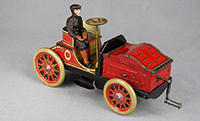 |
||||
|---|---|---|---|---|
 |
Hessmobil racer circa 1905 – L 8” (20.3 cm) W 3.125” (8 cm) H 4.375” (11 cm) The Hessmobil racer followed the style of the day as full size automobiles proved and promoted themselves on the racetrack. This piece is sometimes seen with a mechanic sitting next to the driver and also came with flags to denote country of origin. This design follows the Gordon Bennett Cup racing car style, a race held from 1900 to 1905. As the races were between national teams, it led to the reorganization and standardization of national racing colors. Britain had to choose a different color (shamrock green) to its usual national colors of red, white and blue, as these had already been taken by Italy, Germany and France respectively. This Hessmobil racer was produced in red, blue, green and tan. |
|||
 |
Hessmobil Roadster - Car:L 25cm, W 9.5cm, H 12.4cm, circa 1900 Marked: “Hessmobil”, “H” shield logo, “JLH” logo, “Germany”, D.R. Pat., 4, D.R.G.M., U. St. Pat. A.f. Probably one of the most produced Hessmobils, it was once seen quite often offered for sale. As more and more antique toys go into collector’s hands, they are seldom seen offered anymore. This particular piece was probably one of the Hess factory’s early staple toys at the time. Cranked flywheel power actuated by up and down movement of steering wheel. Front wheel drive. This example obtained from an auction house in Finland and is as close to mint as I have seen. It is an early example with an external spring on the crank handle and the original bisque driver. There were several modifications to the crank / flywheel drive mechanism as Hess improved this over the life of the toy. |
|||
 |
Hess 1060 Auto, Rubber Tires, Tin Tires, Circa 1900 Before Hess renamed their automobiles “Hessmobil”, they were named and labeled “Hess Auto”. Shown are two examples of these early autos, one with tinplate wheels and tires, the other an unusual and hard to find example with rubber tires. The rubber tired version is one of the few toys in my collection with a complete ownership history. This auto was originally purchased by a Frenchman who moved to Brazil in 1910. The toy was given to his son who was born in 1915. The painted bisque driver, although missing part of his arm, is original to the vehicle. Another interesting note is the extension rising from the right front fender. It appears that a flag of some sort may have been original to the vehicle.
|
|||

